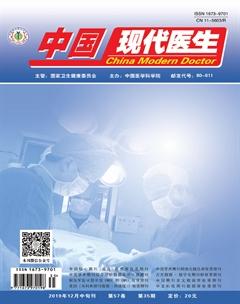射频消融术后阵发性房颤患者心率减速力对复发的影响及临床意义
张芸芸 周建国


[摘要] 目的 探討射频消融术后阵发性房颤患者心率减速力(DC)对复发的影响及临床意义。 方法 选取2013年1月~2016年11月在心内科行左房环肺静脉消融术(CPVI)治疗阵发性房颤(PAF)的患者80例,分别在术前、术后3 d、3个月和6个月定期随访,行24 h动态心电图检查,根据术后3个月的随访结果将患者分为未复发组(56例)及复发组(24例)。记录各时期复发组与未复发组患者的心率减速力、心率加速力(AC)和心率变异(HRV),并比较分析。 结果 (1)术后即刻患者与术前比较HRV、DC值、AC值绝对值均明显降低(P<0.01);(2)与术前相比,无论复发组还是未复发组术后各时段DC值均下降(P<0.05),而在复发组,与术后即刻相比,术后3个月DC值升高(P<0.05)。未复发组,术后各时段DC值保持在较低水平,差异无统计学意义;(3)DC>4.5 ms患者的复发率53.5%(15/28)高于DC≤4.5 ms的17.3%(9/52),差异有统计学意义(P<0.01)。 结论 CPVI术后即刻未复发组与复发组DC值均降低,提示迷走神经功能降低;术后3~6个月复发组迷走神经功能恢复较快,未复发组迷走神经保持在较低水平;术后3~6个月DC值>4.5 ms患者复发率增高。
[关键词] 阵发性心房颤动;射频消融术;心率减速力;心脏自主神经
[中图分类号] R541.75 [文献标识码] B [文章编号] 1673-9701(2019)35-0011-04
Effect of heart rate deceleration on recurrence in patients with paroxysmal atrial fibrillation after radiofrequency ablation and its clinical significance
ZHANG Yunyun1 ZHOU Jianguo2
1.Department of Electrocardiogram, Lianyungang Hospital Affiliated to Nanjing University of Chinese Medicine, Lianyungang 222004, China; 2.Department of Radiology, Lianyungang Hospital Affiliated to Nanjing University of Chinese Medicine, Lianyungang 222004, China
[Abstract] Objective To investigate the effect of heart rate deceleration (DC) on recurrence in patients with paroxysmal atrial fibrillation after radiofrequency ablation and its clinical significance. Methods Eighty patients with paroxysmal atrial fibrillation (PAF) who underwent left atrial circumferential pulmonary vein ablation (CPVI) in the Department of Cardiology from January 2013 to November 2016 were enrolled. Regular follow-ups were conducted before surgery and 3 days, 3 months and 6 months after surgery. During the follow-ups, 24 h dynamic electrocardiography was performed. Patients were divided into the non-recurrent group (56 patients) and the recurrent group (24 patients) according to the follow-up results of 3 months after surgery. Heart rate deceleration, heart rate acceleration (AC) and heart rate variability (HRV) were recorded and compared between the recurrent and non-recurrent groups in each period. Results (1) The absolute values of HRV, DC and AC were significantly lower in patients immediately after surgery than those in patients before surgery (P<0.01). (2) The DC values after surgery were decreased in both the recurrent group and the non-recurrent group, compared with those before surgery (P<0.05). In the recurrent group, the DC values 3 months after surgery were higher than those immediately after surgery (P<0.05). In the non-recurrent group, the DC values remained at a lower level at each period after surgery, with no statistically significant differences. (3) The recurrence rate of patients with DC>4.5 ms was higher than that of patients with DC≤4.5 ms, which was 53.5% (15/28) and 17.3% (9/52), respectively. The difference was statistically significant (P<0.01). Conclusion Immediately after CPVI, the DC values of both the non-recurrent group and the recurrent group decreased, suggesting a decrease of vagus nerve function. The vagus nerve function recovers rapidly in the recurrent group 3~6 months after surgery. The vagus nerve function remained at a lower level in the non-recurrent group. The recurrence rate of patients with DC>4.5 ms increases 3~6 months after surgery.
[Key words] Paroxysmal atrial fibrillation; Radiofrequency ablation; Heart rate deceleration; Cardiac autonomic nerve
心房顫动(Atrial fibrillation,AF)是心律失常的常见病之一[1-2],目前临床治疗方法主要包括控制心室率、窦性心律以及导管射频消融。左房环肺静脉射频消融术(Circumferential pulmonary vein isolation,CPVI)是目前AF消融的主流术式之一[3-4],CPVI术消融部位为肺静脉-左房(PV-LA)相接处,重合于心房神经集中的地方,这种手术方式可能对心脏自主神经系统产生影响[5]。心脏的自主神经有迷走神经与交感神经,心率减速力(DC)及心率加速力(AC)能够分别定量迷走与交感神经的张力。既往研究采用反映心脏自主神经的心率变异(HRV)等指标,其方法无法定量分析[6]。而用DC值研究阵发性房颤(Paroxysmal atrial fibrillation,PAF)患者射频消融术后自主神经变化的文献较少,本研究通过比较行CPVI术治疗PAF患者术前及术后各时期复发与未复发患者的DC值变化,探讨射频消融术后阵发性房颤患者心率减速力对复发的影响及临床意义。
1 资料与方法
1.1 一般资料
选取2013年1月~2016年11月于心内科行射频消融术治疗阵发性房颤的患者,纳入标准:(1)年龄18~80岁;(2)符合2014年欧洲心脏病学会阵发性房颤诊断标准[7];(3)非结构性阵发性房颤且经两种以上抗心律失常药物治疗后效果欠佳。排除标准:(1)安装心脏起搏器者;(2)6个月内有心肌梗死或开胸手术史者;(3)甲状腺机能障碍者。入组患者80例,其中男44例、女36例,平均(58.07±11.28)岁。根据随访患者消融术后3个月的结果将患者分为未复发组(56例)及复发组(24例)。两组患者的年龄、性别、房颤病程、合并基础疾病(高血压、冠心病)、DC值、AC值、心超指标比较,差异均无统计学意义(P>0.05),具有可比性。见表1。本研究均经患者及家属知情同意,院伦理委员会批准通过。
1.2 术前准备
所有患者的抗心律失常药物均在术前停用,行24 h动态心电图及超声心动图检查。肺静脉和左心房的结构经心脏CT扫描确定,除外左心耳及左房血栓,在术前48 h内行食道超声心动图检查。
1.3 术后处理及随访
患者术后给予达比加群抗凝,可达龙维持窦性心律,质子泵抑制剂奥美拉唑20 mg qd抑酸,如有不适反应立即记录常规心电图。手术3 d后做动态心电图检查。于术后3个月及6个月评估手术疗效及有无并发症,定期复查心脏超声、24 h动态心电图及常规心电图。
1.4 DC及HRV指标
在术前、术后3天、3个月和6个月全部患者均行动态心电图检查,通过动态心电分析系统把记录回放,去除干扰、伪差,计算DC值、AC值和HRV值[8]。HRV时域指标为SDNN、rMSSD,频域指标为低频成分和高频成分的比值(LF/HF)。
1.5 术后房颤复发定义
房颤射频消融术后3个月为手术损伤期,故本研究将术后3个月患者出现心动过速的症状,或24 h动态心电图中出现房颤、房扑或房速超过30 s作为术后复发。
1.6 统计学方法
采用SPSS22.0统计学软件包进行数据统计分析,计量资料经检验符合正态发布,以均数±标准差(x±s)表示,采用两独立样本t检验;ANOVA方差分析用于多组间比较;采用乘积极限法(Kaplan-Meier法)分析DC值对术后复发率的影响。P<0.05为差异有统计学意义。
2 结果
2.1 术后即刻DC、AC及HRV与射频消融术前比较
80例患者中有24例于术后3个月出现复发,比率为30%。患者术后即刻与术前比较DC值、AC绝对值及HRV均显著降低(P<0.01),平均心率升高(P<0.01)。见表2。
2.2 复发组术前、术后各时段DC值和AC值与未复发组比较
与术后3个月未复发组相比,复发组DC值和AC绝对值升高(P<0.05);与术前相比,无论复发组还是未复发组术后各时段DC值和AC绝对值均降低(P<0.05)。而在复发组,与术后即刻相比,术后3个月DC值和AC绝对值升高(P<0.05)。在未复发组,术后各时段DC值和AC绝对值保持在较低水平,差异无统计学意义(P>0.05)。见表3。
2.3 不同DC值对术后复发率的影响
DC≤4.5 ms提示迷走神经张力降低,将术后3~6个月患者分为DC≤4.5 ms者和DC>4.5 ms者。根据Kaplan-Meier复发分析结果显示:DC>4.5 ms患者的复发率为53.5%(15/28),明显高于DC≤4.5 ms的17.3%(9/52),差异有统计学意义(P<0.05)。
3 讨论
AF的发生与心脏自主神经有关[9],患者一旦发生AF,心房的组织重构可促使其自身的维持和复发。AF临床治疗方法较多,导管消融治疗的主要机制是破坏房颤的启动基质及自主神经对心脏的调控,通过电隔离肺静脉使心房达到去迷走效应。因此,迷走神经的损伤有利于提高肺静脉诱导房颤消融的疗效[10]。
目前,通过DC值评价迷走神经的功能备受关注,既往研究表明DC值可不受外界因素影响,实现对自主神经作用的直接检测[11]。Patterson等[12]研究认为交感与副交感神经递质可共同导致肺静脉的快速放电,消融术中尚无法单独去除迷走神经支配。虽然DC与AC都能定量测定迷走神经及交感神经,但DC测定结果与临床循证医学的结果更为符合[13],并且迷走神经张力的改变能促使房颤复发,即使刺激正常心脏的迷走神经也能使心房有效不应期缩短[14],故术后迷走神经张力的变化推荐应用DC值进行分析。Bauer等[15]通过临床研究随访心肌梗死患者,提议以2.5 ms和4.5 ms作为分界线,分为低危值、中危值及高危值。DC≤4.5 ms提示迷走神经张力降低,本研究将术后3~6个月患者分为DC≤4.5 ms者和DC>4.5 ms者。与术前相比,术后即刻无论复发组还是未复发组患者DC值、AC绝对值均降低,提示术后迷走-交感神经的调节功能均下降。发现术后3个月及6个月的患者未复发者与复发者DC值均呈上升趋势;在复发组,与术后即刻相比,术后3个月DC值升高(P<0.05);而在未复发组,术后各时段DC值保持在较低水平,差异无统计学意义(P>0.05),表明由肺静脉诱导的房颤消融术后的疗效可能与迷走神经持续损伤有关;与术后3~6个月DC≤4.5 ms患者相比,DC>4.5 ms患者的复发率较高。既往研究表明术后迷走神经损伤不是永久性的,存在自我修复功能[16],本研究结果与其类似。
綜上所述,CPVI术后即刻未复发组与复发组DC值均降低,提示迷走神经功能降低;术后3~6个月复发组迷走神经功能恢复较快,未复发组迷走神经保持在较低水平;术后3~6个月DC值>4.5 ms患者复发率增高。本研究样本量不足,可能使统计学结果产生偏倚,有待加大样本量进一步深入研究。
[参考文献]
[1] Rademacher W,Seeck A,Surber R,et al. Multidimensional ECG-based analysis of cardiac autonomic regulation predicts early AF recurrence after electrical cardioversion[J]. J Electrocardiol,2016,45(2):116-122.
[2] Zhao R,Li D,Zuo P,et al. Influences of age,gender,and circadian rhythm on deceleration capacity in subjects without evident heart diseases[J]. Ann Noninvasive Electrocardiol,2018,20(2):158-166.
[3] Wang YP,Kuo TB,Lai CT,et al. Effects of breathing frequency on the heart rate deceleration capacity and heart rate acceleration capacity[J]. Eur J Appl Physiol,2017, 115(11):2415-2420.
[4] Gao L,Chen YD,Shi YJ,et al. Value of DC and DRs in prediction of cardiovascular events in acute myocardial infarctionpatients[J]. Zhonghua Yi Xue Za Zhi,2016,96(19):1519-1522.
[5] Kisohara M,Stein PK,Yoshida Y,et al. Multiscale heart rate dynamics detected by phaserectified signal averaging predicts mortality after acute myocardial infarction[J]. Europace,2017,15(3):437-443.
[6] Liu Y,Syed Z,Scirica BM,et al. ECG morphological variability in beat space for risk stratification after acute coronarysyndrome[J]. J Am Heart Assoc,2016,3(3):135-143.
[7] Gao L,Chen YD,Shi YJ,et al. Prediction value of deceleration capacity of rate and GRACE risk score on major adverse cardiac events in patients with acute myocardial infarction[J]. Zhonghua Xin Xue Guan Bing Za Zhi,2016, 44(7):583-587.
[8] Zuern CS,Rizas KD,Eick C,et al. Severe autonomic failure as apredictor of mortality in aortic valve stenosis[J].Int J Cardiol,2018,176(3):782-787.
[9] Zuern CS,Eick C,Rizas KD,et al. Severe autonomic failure in moderate to severe aortic stenosis:Prevalence and association with hemodynamics and biomarkers[J]. Clin Res Cardiol,2017,101(7):565-572.
[10] Schaeffer BN,Rybczynski M,Sheikhzadeh S,et al. Heart rate turbulence and deceleration capacity for risk prediction of serious arrhythmic events in Marfan syndrome[J]. Clin Res Cardiol,2016,104(12):1054-1063.
[11] Guzik P,Piskorski J,Barthel P,et al. Heart rate deceleration runs for postinfarction risk prediction[J]. J Electrocardiol,2017,45(1):70-76.
[12] Eick C,Rizas KD,Meyer-Zürn CS,et al. Autonomic nervous system activity as risk predictor in the medical emergency department:A prospective cohort study[J]. Crit Care Med,2016,43(5):1079-1086.
[13] Demming T,Sandrock S,Kuhn C,et al. Deceleration capacity:A novel predictor for total mortality in patients with nonischemic dilated cardiomyopathy[J]. Int J Cardiol,2016,22(1):289-293.
[14] Bas R,VallverdúM,Valencia JF,et al. Evaluation of acceleration and deceleration cardiac processes using phaserectified signal averaging in healthy and idiopathic dilated cardiomyopathy subjects[J]. Med Eng Phys,2018, 37(2):195-202.
[15] Zou C,Dong H,Wang F,et al. Heart acceleration and deceleration capacities associated with dilated cardiomyopathy[J]. Eur J Clin Invest,2018,46(4):312-320.
[16] Arsenos P,Manis G,Gatzoulis KA,et al. Deceleration capacity of heart rate predicts arrhythmic and total mortality inheart failure patients[J]. Ann Noninvasive Electrocardiol,2016,21(5):508-518.
(收稿日期:2019-09-30)

